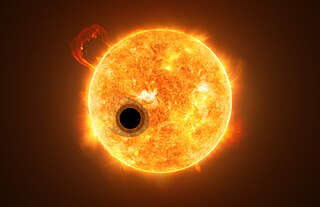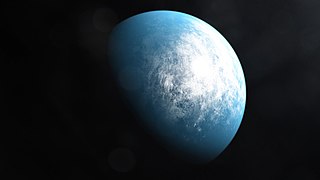Related Research Articles
Pi Mensae, also known as HD 39091, is a yellow dwarf star in the constellation of Mensa. This star has a high proper motion. The apparent magnitude is 5.67, which can be visible to the naked eye in exceptionally dark, clear skies. It is nearly 60 light-years away. The star is slightly larger than the Sun in terms of mass, size, luminosity, temperature and metallicity, and is about 730 million years younger. It hosts three known planets.

Planet Hunters is a citizen science project to find exoplanets using human eyes. It does this by having users analyze data from the NASA Kepler space telescope and the NASA Transiting Exoplanet Survey Satellite. It was launched by a team led by Debra Fischer at Yale University, as part of the Zooniverse project.

WASP-107b is a super-Neptune exoplanet that orbits the star WASP-107. It lies 200 light-years away from Earth in the constellation Virgo. Its discovery was announced in 2017 by a team led by D. R. Anderson via the WASP-South.
TOI-700 is a red dwarf 101.4 light-years away from Earth located in the Dorado constellation that hosts TOI-700 d, the first Earth-sized exoplanet in the habitable zone discovered by the Transiting Exoplanet Survey Satellite (TESS).

TOI-700 d is a near-Earth-sized exoplanet, likely rocky, orbiting within the habitable zone of the red dwarf TOI-700, the outermost planet within the system. It is located roughly 101.4 light-years (31.1 pc) away from Earth in the constellation of Dorado. The exoplanet is the first Earth-sized exoplanet in the habitable zone discovered by the Transiting Exoplanet Survey Satellite (TESS).
Kepler-410 is a binary star system. Its primary star, also known as Kepler-410A, is a F-type subgiant star, orbited by the orange dwarf star Kepler-410B on a wide orbit. The companion star was discovered in 2012.
L 98-59 is a bright M dwarf star, located in the constellation of Volans, at a distance of 10.608 parsecs, as measured by Gaia.
TOI-1452 b is a confirmed super-Earth exoplanet, possibly a water world, orbiting a red-dwarf star TOI-1452 about 100 light-years away in the Draco constellation. The exoplanet is about 70% larger in diameter than Earth, and roughly five times as massive.
TESS Hunt for Young and Maturing Exoplanets (THYME) is an exoplanet search project. The researchers of the THYME collaboration are mainly from the United States and search for young exoplanets using data from the Transiting Exoplanet Survey Satellite (TESS). The new discoveries should help to understand the early evolution of exoplanets. As of March 2023 the collaboration produced 9 papers announcing the discovery of exoplanets.
The TESS-Keck Survey or TKS is an exoplanet search project that uses the Keck I and the Automated Planet Finder (APF) to conduct ground-based follow-up of planet candidates discovered by the Transiting Exoplanet Survey Satellite. The TKS aims to measure the mass for about 100 exoplanets and has been awarded some of the largest time allocations in the histories of Keck I and APF. The program has four main science themes:
- the bulk compositions of small planets
- dynamical temperatures and system architectures
- a larger, more refined sample for future atmospheric studies
- planets orbiting evolved stars
References
- ↑ Yu, Liang; Vanderburg, Andrew; Huang, Chelsea; Shallue, Christopher J.; Crossfield, Ian J. M.; Gaudi, B. Scott; Daylan, Tansu; Dattilo, Anne; Armstrong, David J.; Ricker, George R.; Vanderspek, Roland K.; Latham, David W.; Seager, Sara; Dittmann, Jason; Doty, John P.; Glidden, Ana; Quinn, Samuel N. (2019), "Identifying Exoplanets with Deep Learning. III. Automated Triage and Vetting of TESS Candidates", The Astronomical Journal, 158 (1): 25, arXiv: 1904.02726 , Bibcode:2019AJ....158...25Y, doi: 10.3847/1538-3881/ab21d6 , S2CID 102351917
- 1 2 Knudstrup, E.; Albrecht, S. H.; Gandolfi, D.; Marcussen, M. L.; Goffo, E.; Serrano, L. M.; Dai, F.; Redfield, S.; Hirano, T.; Csizmadia, Sz.; Deeg, H. J.; Fridlund, M.; Lam, K. W. F.; Livingston, J. H.; Luque, R.; Narita, N.; Palle, E.; Persson, C. M.; Van Eylen, V.; Vincent Van Eylen (2023), "A puffy polar planet. The low density, hot Jupiter TOI-640 b is on a polar orbit", Astronomy & Astrophysics, 671, arXiv: 2302.01702 , Bibcode:2023A&A...671A.164K, doi:10.1051/0004-6361/202245301, S2CID 256537549
- ↑ Lester, Kathryn V.; Howell, Steve B.; Ciardi, David R.; Matson, Rachel A. (2022), "Determining Which Binary Component Hosts the TESS Transiting Planet", The Astronomical Journal, 164 (2): 56, arXiv: 2206.02825 , Bibcode:2022AJ....164...56L, doi: 10.3847/1538-3881/ac75ee , S2CID 249431677
- ↑ Rodriguez, Joseph E.; et al. (9 February 2021). "TESS Delivers Five New Hot Giant Planets Orbiting Bright Stars from the Full-frame Images". The Astronomical Journal. 161 (4): 194. arXiv: 2101.01726 . Bibcode:2021AJ....161..194R. doi: 10.3847/1538-3881/abe38a . S2CID 230770138.
- ↑ "Exoplanet-catalog". Exoplanet Exploration: Planets Beyond our Solar System. Retrieved 22 March 2021.